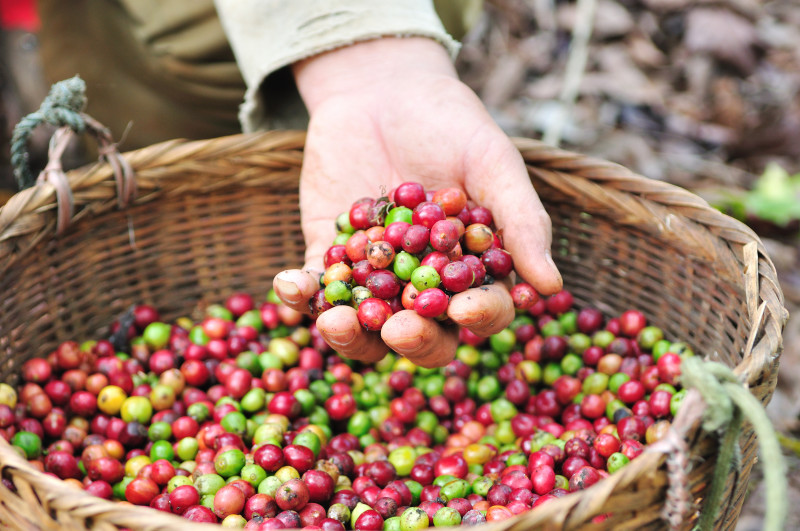Ecuador is situated along the equator between two classic coffee countries, Colombia to the north and Peru to the south, Ecuador surprisingly isn’t known for producing great coffee. The country is home to the Galápagos Islands, which are just one example of its diverse ecological systems — there are twice as many plant and animal species in the little country as there are in the United States and Canada combined — several of which are well-suited for growing specialty grade coffee. Sourcing coffees from these unique microclimates remains difficult, which is why it’s so exciting when we do have a bag of Ecuadorian coffee to roast and offer.
Ecuador’s Coffee Industry Began in 1860
Coffee was first commercially grown in Ecuador in 1860. Beans were initially planted in the Manabi region, which remains the largest-producing region in the country (partly because it’s geographically the largest region suitable for coffee farming).
The industry continued to grow, eventually spreading to a total of seven regions, until the 1970s. In the 1980s, however, low international prices for coffee hurt Ecuador’s coffee industry. (Ecuador was hardly the only South American country to suffer from low coffee prices in the 1980s. In many nearby countries the industry also suffered.)
Ecuador Imports More Coffee Than It Exports
Today, Ecuador’s coffee industry is more focused on brokering deals for low-grade coffee that’s used to make instant coffee.
In fact, Ecuador is the only coffee-producing country that imports more coffee than it exports. Ecuadorians have a seemingly insatiable thirst for soluble coffee, which they import low, low-grade robusta coffee from Vietnam to make. Ecuador’s robusta and low-grade arabica beans are also used for soluble coffee, but their often first exported through Colombia and to higher-paying markets.
Ever since 2000, the low commercial-grade coffee industry has exceeded the specialty-grade market in Ecuador because:
- Ecuador has positioned itself as a major exporter of soluble coffee
- there is a lot of government support for robusta and low-grade arabica farmers, but little for specialty-grade arabica producers
- unlike other coffee-growing countries (e.g. Colombia and Tanzania), Ecuador doesn’t have a strong coffee agency that provides technical assistance and promotes good farming practices
- many coffee farmers’ children are moving to the United States
- coffee farmers face other struggles, such as El Niño, higher labor costs than neighboring countries
- elevations in some coffee-growing regions in the country aren’t suitable for growing specialty-grade arabica beans
There are Seven Growing Regions in Ecuador
Coffee is grown in seven different regions in the country, although some of these regions produce low-quality coffee, which is locally known as bola.
- Manabi, which lies along the Pacific Coast, produces about half of Ecuador’s arabica coffee. The region’s high humidity and low elevations (200 to 700 meters above sea level) aren’t conducive to growing good arabica coffee, though. The coffee grown here is almost all low-quality natural, or bola.
- Coffee is grown on the Galápagos Islands, but farmers here face similar challenges to those in Manabi. Elevations on the Galápagos range between 300 and 400 meters above sea level. and humidity is extremely high. The coffee farms on the Galápagos Islands may have more flora and fauna than any other farms in the world, but they don’t have the best coffee.
- Carchi lies in Northern Ecuador and borders Colombia. The country’s influence is evident on farms throughout this region. For instance, many coffee farmers in Carchi grow Colombia and Castillo varietals, which are widely used in Colombia because they have good potential and resist coffee rust. Carchi has elevations between 1,200 and 1,800 meters, and it could become known for its good-quality coffee.
- Pichincha is another region in Northern Ecuador, although it’s not as close to Colombia. While this region currently isn’t too well known, it’s perhaps the most promising in all Ecuador. Pichincha, which lies in the Andes, has elevations between 1,000 and 1,800 meters — high enough for growing high-scoring arabica coffees. Additionally, the capital of Ecuador, Quito, is in Pichincha, which may make exporting coffee more feasible from this region than it is from others. Many of the coffee farmers in Pichincha are first-generation producers. As they become more established, this region’s coffee industry could take off.
- Loja, which is in Southern Ecuador, produces most of the country’s high-grade arabica coffees — and some of the country’s highest-scoring coffees. Many finalists in the Taza Dorada, Ecuador’s coffee competition, have come from this region, and some of them have won. Elevations in Loja are between 1,000 and 2,000 meters, and the region produces 20 percent of Ecuador’s arabica coffee (including both low- and high-grade arabica).
- Both Zamora-Chinchipe and El Oro are also in Southern Ecuador, near Peru. These regions don’t have elevations as high as Loja (elevations in Zamora-Chinchipe are between 800 and 1,800 meters, and those in El Oro range from 500 to 1,300 meters), but good arabica coffee can be grown in some parts of these regions. Many of the farms in both regions are small family-run farms, and a number of them are certified organic. Our Ecuador Acrim comes from Zumba, which is in this region and very close to Peru.
There is a Shortage of Mills in Ecuador
Growers in the regions that are suitable for growing high-grade coffee face one significant challenge: a shortage of processing mills. In 2015, there was just one mill in Quito, a few in Guayaquil (in Manabi), and a few in Loja.
Because of the shortage, only 15 percent of the coffee in Ecuador is washed. Naturally processed (unwashed) coffees can be great, but natural coffee’s in Ecuador typically aren’t selectively picked or sorted. Thus, they tend to be lower-grade because bad beans are left in with good ones.
Getting Coffee from Ecuador is a Logistical Logjam
Right now, the biggest challenge to getting Ecuador’s high-quality coffees into the United States is logistical. The country’s capable of producing lots that score 90-plus (on a 100-point scale), but it’s difficult for importers to fill an entire container of high-quality coffee. The country produces only about 100 containers of specialty-grade arabica coffee annually. In comparison, Colombia exports 32,000 containers each year.
If importers can’t fill a container, or at least half of one, it’s not economically feasible to ship the coffee to the United States. Shipping costs are simply too high to send partially filled containers.
Check Our Current Offerings for Ecuadorian Coffee
Because Ecuadorian coffee can be great but is difficult to source, it’s special when you can find some. We are excited to have a coffee from Ecuador for the first time. (If you missed that offering, check back at our current offerings to see if we have another one in.)

